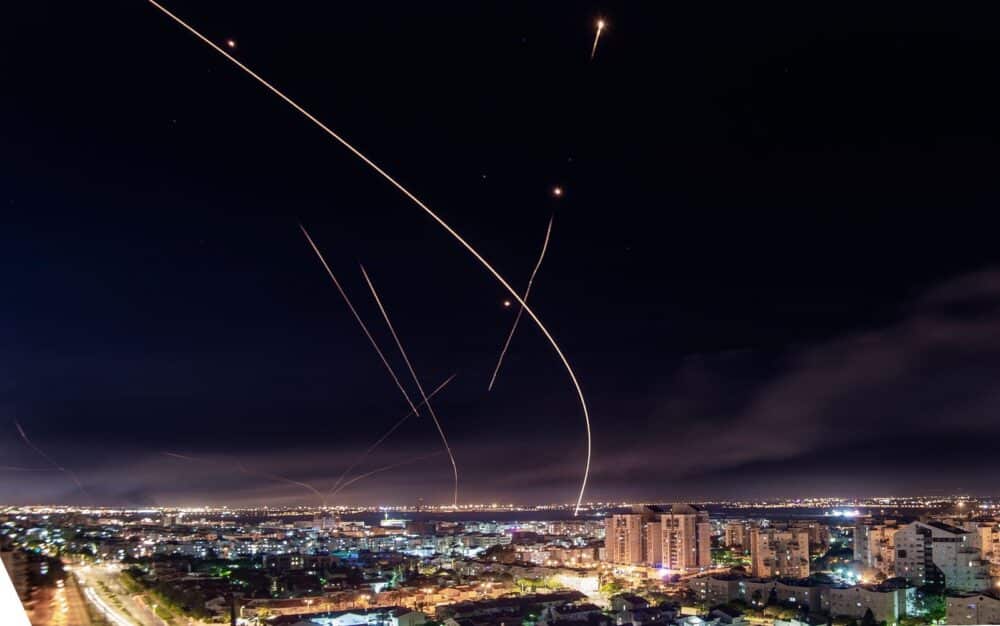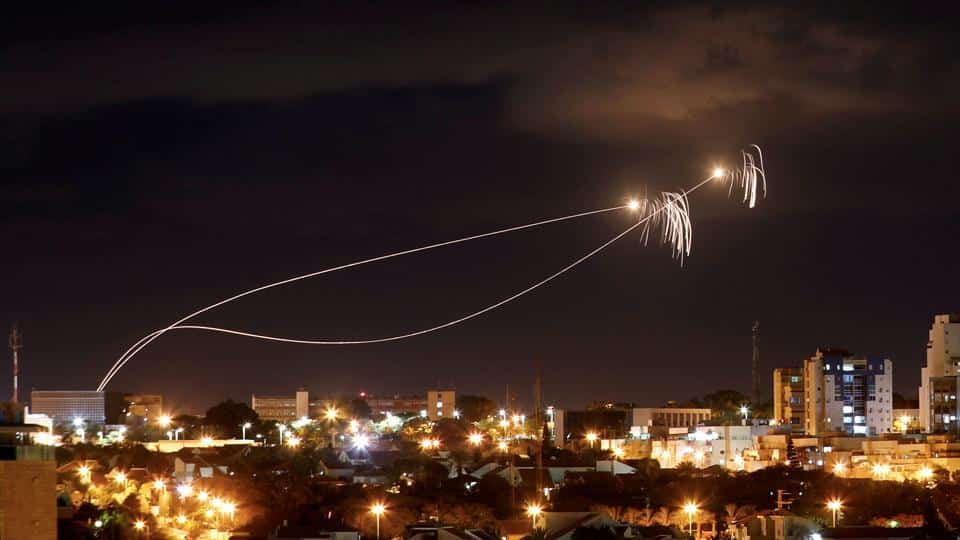What Is The Iron Dome of Israel?
Back Story & History on “Israel’s Iron Dome” Missile Defense System: Another Take
By Liz Mumbi | Staff Writer | Eternal Affairs Media
The most common visualization of the Iron dome is streaks of light in the night as the system intercepts projectiles being fired into Israeli cities such as Ashkelon.
To better understand how the Iron Dome of Israel functions, it is important to contextualize the ingenious military facility from a historical point of view.
The Founding of Israel Is the Genesis of Security Risks
On November 29, 1947, Resolution 181, or the Partition Resolution, was adopted by the United Nations. This was a culmination of sustained effort to find a home for the Jewish people on a land that they believed to be their cradle, according to Abrahamic religious texts.
In the treaty, the land was divided as per religious inclinations, with the Arab Muslim population being assigned the West Bank, Golan Heights, and Gaza regions, while the Jewish citizens were given control over the rest of the then Palestinian territory.
The embers of rebellion from the Palestinian population and the neighboring Arab states of Egypt, Jordan, Syria, and more sparked a full-scale conflict on May 15, 1948, when the British mandate ended. The change ushered in a new era with David Ben-Gurion, the head of the Jewish Agency, declaring independence for a new Israel state.
Consequently, the Tel Aviv attack that started a day earlier intensified with Arab powers such as Iraq joining hands with the Palestinians to edge out the Jewish people, culminating in the Arab- Israeli war of 1945-1949. Although Israel lost some territories, it could hold the fort and repel the warring side’s advancement into key settlements such as Haifa.
The other half of the century and the earlier 21st century were defined by wars such as the: –
- 1956 Suez Crisis
- 1967 Six-Day War or the June war
- 1973 Yom Kippur War
- 1982 Lebanon War, the Israelis shelled Lebanon in pursuit of the Palestinian Liberation Organization (PLO) domiciled in Beirut. The Israelis were almost capturing Beirut before they opted for an armistice with the PLO.
- 2006 Second Lebanon War, Israel was responding to the Hezbollah’s random attacks into Israeli territories from Lebanon.
Fast forward to the current time, the territory has two de-facto governments of Palestine governing some territories of West Bank, Gaza, and East Jerusalem, and the Knesset-led government controlling the rest of the territory.
Even though Israel has always emerged victorious in these conflicts, the security situation has not improved. The core grievances of the dissident Palestinians and their Arab sympathizers have never been addressed.
Additionally, efforts such as creating a unified state for all have hit rock bottom, and there is no hope in sight that peace will prevail in the Near East region with a rich history dating to antiquity.
Developing a Pro-Active Defense Mechanism
The first attempt to develop a sustainable security solution was to build barriers to separate the Israeli population from Palestinians. According to government operatives, the walls are a cure to the endless random attacks on people consisting of suicide bombings, knife attacks on town squares, and shooting of civilians that were the order of the day, especially in the late 90s.
Despite criticism from quarters such as the International Court of Justice, Israel erected walls in the West Bank region in 2002. The 700-kilometer wall cut through farms and settlements and cut non-citizen Arabs from accessing the country.
In the same year, the Gaza wall was constructed along the entire Gaza strip. Fourteen years down the line, in 2016, the wall was fortified with an underground wall, surveillance system, and a sea barrier that makes it the most advanced military installation.
The Development of the Iron Dome
However, the aerial attack was an everyday reality, and dissidents in regions such as Gaza and the Golan heights could launch offenses such as short-range missiles into the country.
In 2005, Gen. Danny Gold, the then head of Maf’at built a concept for intercepting offenses. In 2005, the government approved the project, and Rafael Advanced Defense Systems and Israel Aerospace Industries won the contract for the project.
4 years into the project, the prototype was ready for trials, and the maiden test was done in July 2008 when the Tamir Adir Missile Interceptor System stopped a missile. The sea-based system is vital in protecting the navy and sea installations from short-range missiles.
In March and July 2009, trials for the defense system were successful in intercepting projectiles such as rockets.
In August 2009, the Israeli government formed a new battalion under the Air Force Air Defense Unit mandated with operating the iron dome. There were plans to launch the defense system in 2010, but the plans were shelved after deploying the facilities to the borders of Lebanon and Gaza, where Hezbollah and Hamas operatives were active.
According to the then Defense Ministry Director-General Pinhas Buchris, the Iron Dome was the panacea to resolving the security breaches in the Northern and Southern Parts of Israel. The system was designed to only target projectiles directed at populated areas and ignore those that pose no threat to the citizens to increase their efficiency.
After a series of trials, modifications, and enhancements, the Iron Dome was launched and deployed in March 2011 by Defense Minister Ehud Barak.
In the literal sense, the iron dome creates impermeable airspace that can provide a shield against projectiles.
From a technical standpoint, the Iron dome entails three key components:
- Detection and Tracking Radar
- Battle Management and Weapon Control (BMC)
- Missile Firing Unit
Detection and Tracking Unit
The iron dome’s detection and tracking feature is known as the ELM-2084. is designed and built by IAI’s ELTA division. Elta is an Israeli firm that is a member of the Israel Aerospace Industry.
For an anti-missile system to be effective it must be equipped with a radar system to spot and track projectiles. Hence the ELM-2084 tracks projectiles from their firing point to the target given the nature of the small landmass involved.
On the other hand, missiles and advanced rockets can be equipped with a “proximity fuse” which is a “laser-controlled fuse” that enables attackers to direct projectiles to a specific target with precision. When the target is in range, the missile is activated by blasting the shell with inbuilt shrapnel which results in a blast that can intercept the target and prevent it from shelling buildings and key infrastructure.
Battle Management and Weapon Control (BMC)
The BMC system is designed and developed by mPrest Systems, an Israeli software company. It is designed to process the data from the radar system and analyze it’s the risks that the specific projectile poses to the population. This is the feature that enables the smart and futuristic I Dome version to rank the threats and only attack rockets that may cause greater property damage and loss of lives and injuries. The whole idea of the BMC is to cut operational costs and limit unnecessary launches interceptor.
Missile Firing Unit
When the BMC registered a potential threat, a command is autogenerated which launches the Tamir missile. The maneuverability of the Tamir missile is greatly enhanced and sophisticated to a point that critics of the Iron dome always point out that the defense mechanism is too advanced for the artilleries that the Hamas and Hezbollah militants use.
Nonetheless, the interceptor missile is enhanced by electro-optic sensors that enable the system to steer the weapon to the target. It also contains steering fins to smoothen its maneuverability.
The Iron Dome can track and intercept the short-range missile and projectiles within a specific range of distance ranging from 4 to 70 kilometers. The system fires the Tamir missiles to counter the oncoming projectile barring its advancement.
The General Design of the Iron Dome
The battery units are built to withstand all-weather situations such as storms, dust, fog, rain, low clouds, or other conditions. It is also mobile and can be deployed to different areas on short notice, depending on the security risk. It has a launcher that deploys the missiles at a go.
To protect the operators in case the batteries are a target of the attackers, the pieces of equipment are not manually operated. They are remotely controlled through wireless connections.
One battery can protect up to 150 square kilometers of an area. Currently, there are ten known batteries in the country. The defense ministry aims to increase the number to 15 to provide “full protection” to the citizens.
Each battery has 3 launchers with 20 interceptors each. Each interceptor has one Tamir missile, which gives a battery the capacity to fire 60 missiles to counter an attack. The unit can then be replenished, and the cycle of defense can continue.
The Iron Dome Is Being Evolved
The capabilities of the Iron Dome are being constantly improved as war dynamics change. According to the head of Rafael’s Air and Missile Defense Division Brig. Gen. (Res.) Pini Yungman, there is a need to offer an additional layer of protection.
For instance, Hamas has acquired sophisticated Fajr-5 long-range missiles from Iran. Additionally, the threat of Iran attacking the country with ballistic missiles is imminent. Therefore, the defense unit is investing millions of dollars into making the iron dome more equipped to handle advanced aerial artillery.
The first significant improvement was done in 2012. According to the minister of defense at Ehud Barak, the exercise on the 5th battery gave it the capacity to intercept medium-range missiles from Syria and Gaza at the height of the Syrian Civil war. Consequently, the fifth battery had an improved range of 150 kilometers from the initial 70 kilometers, which protected the country from projectiles that could reach its center.
Another turning point for the defense system was in 2020. The developer was able to integrate the solid-state laser surveillance capabilities that have greatly enhanced the surveillance and tracking capabilities of the system.
According to the Jerusalem Post, the next significant upgrade was in March 2021, when improvements to the Iron Dome marked a big leap in Israel’s security situation. The system could counter Iranian Cruise missiles and Drones in a simulation.
The Israel Missile Defense Organization (IMDO) collaborated with Advanced Defense Systems in the program under the defense ministry. Tests also showed that the revamped system could offer protection against a barrage of rockets that the Hamas team has been hurling in the country hoping that a few rockets would be missed by the iron dome and hit the targets.
As a result, the country has deployed the Iron dome to its marine zone. The system is being installed on Israeli naval ships and sea installations as protection against rockets, unsupervised aerial vehicles (UAVs), and missiles.
The iron dome is being deployed to areas outside the Israel domain where the Israelis have a vested interest. For instance, the nation has discovered huge reserves of natural gas that it aims to exploit. Additionally, the Eastern Mediterranean pipeline will be built to connect Greece via Cyprus, and there is a need to protect these installations from sabotage.
Iron Dome is Being Deployed to Other Regions
Although the US has injected hundreds of millions of dollars into the Iron Dome system as an aid package to its ally, it has not adopted the technology on its mainland until recently. On two occasions, the US Congress voted to fund the iron dome with $205 million and $70 million, indicating unwavering support from Israel’s oldest ally.
As of 2022, the US army has procured the technology and has developed its version of the Tamir missile known as the Skyhunter. Israeli Defense Ministry Benny Gantz is confident that the US army would find the system beneficial in their peace-keeping missions worldwide.
US allies such as Saudi Arabia have been mulling adopting the Iron Dome technology to shield their strategic installations from the Houthi rebels. However, little is known about whether the deal went through.
On the other hand, Ukraine has expressed interest in acquiring Iron Dome batteries following the Russian invasion. However, Israel has backed out of the agreement to avoid stoking any conflict with Russia.
However, the Israeli government has not shelved these plans, especially after the US Congress approved a massive omnibus 2022 spending bill for the Iron dome. The US is an ally of the Ukrainian regime, and Israel may opt to deliver the batteries to Ukraine when called upon to do so.
The Financial Implications of the Iron Dome
Cumulatively, Israel has received over $124 billion from the US in military aid. $1 billion of this has gone towards funding the Iron Dome program.
Estimates show that a single interceptor shot costs about $150,000. Some critics have been questioning the rationale of having an expensive system to counter projectiles that cost Hamas $2,000 to $5,000 per unit.
However, with an accuracy rate of 90%, the Iron Done has been able to save countless lives and property from being shelled by war operatives in the region, according to most military analysts. Most importantly, it provides security insurance commensurate with the ever-present threat from Gaza and the Golan Heights.
With improved capabilities for tackling medium-range missiles, the evolution of the iron dome is on course to resolving the age-old security problem that the country faces.
The military has developed a defense mechanism against long-range missiles by launching David’s Sling system to bridge the system’s shortcomings.












